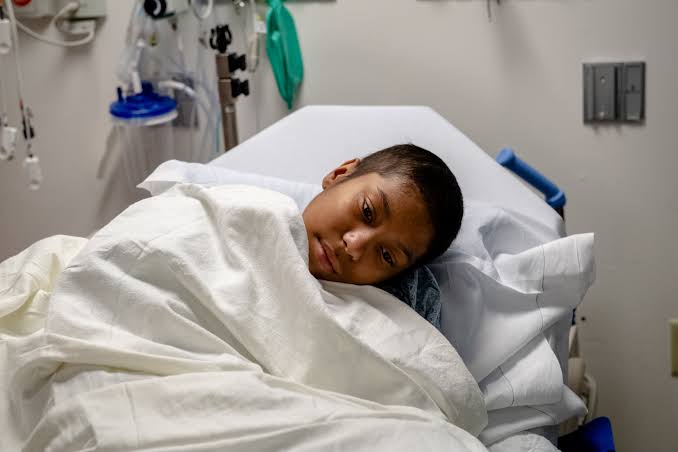Hi. My name is Timi. It is nice to meet you on the other side of this screen. I have faced a lot of health challenges since I was 2 years old. I am in pain a lot of the time. I go in and out of hospitals. I have been called an invalid many times. It is not my fault. I go through all these because I was born with the Sickle Cell Disease. I am sure you must have heard about it. I am a warrior, fighting constantly for my health, against bad comments from my colleagues and even my own thoughts that I cannot keep fighting for long. But it is a battle I am determined to win. Come have a sneak peek into my world.
Sickle Cell Disease is a large term for genetic (inheritable) diseases in which there is an abnormality in the protein molecules that help me to carry oxygen to my cells.

My doctors call this abnormal protein Haemoglobin S (HbS). There are different kinds of abnormal hemoglobin that can be formed and they are looked at in pairs. We have HbSS, HbSC, Hbβ+, Hbβ0, HbSC, HbSD, HbSE, and lots more while the last two are rare. The most common of them all is the HbSS type which I have.
INHERITANCE PATTERN
The Sickle cell disease is transmitted from one’s parents in an autosomal recessive fashion. That means both parents need to have faulty genes to transmit it down to the child before there can be a manifestation of the disease.
MECHANISM
Normal forms of the Haemoglobin protein is the Haemoglobin A type, (HbAA). This protein is extremely functional in the Red cells, which are small nice, round, flexible, discoid structures that are transported in blood. The Red cells, with the help of the Haemoglobin they carry, transport oxygen and nutrients to distant organs in the body. When they reach very small and tiny blood vessels in the body, these red cells can adjust their shape, as they are flexible, so that they meander and successfully pass through to reach the body organs.
But with the faulty Haemoglobin SS, when exposed to certain condition, such as low oxygen levels, the red blood cells assume a rigid, spicule-like, and sickled shape, which distorts their outward shape. Thus, they are unable to pass through the vessels. They clog up the vessels and prevent the organs that they supply from getting enough oxygen and nutrients.
Because of this deprivation, some cell deaths begin to occur which is often experienced as pain, in different parts of the body.
Aside from this, it makes the red cells very fragile. They break up easily. Usually, healthy red cells can last up to 120 days, but these sickled cells barely last up to 30 days.

SYMPTOMS
Though these vary a lot from person to person, common symptoms include;
• Anaemia or paleness/pallor: Because the red cells are often fragile, they break up more easily at a rate faster than the body can produce. So, cell disease patients are often subjected to extended periods of having low blood levels. As these cells are unable to transport oxygen and nutrients which are needed for the body’s chemical activities, they often become easily tired.
• Episodes of pain referred to as vaso-occlusive crises: Pain can occur anywhere the sickle-shaped cells block up the tiny vessels. It could occur in the chest, abdomen, joints, or bones. If the pain is severe, hospitalization may be necessary.
• Painful swellings of the hand and foot/ Dactylitis/ Hand-and Foot Syndrome: This occurs when the blood supply to the hands or feet are compromised. It is very painful and often occurs in children that are less than 2 years.
• Frequents infections: A major organ in the body that helps to sieve out certain bacterial organisms is the Spleen. The spleen is not fully functional in people with Sickle cell Disease. Thus, they are prone to infections a lot more than others.
• Delayed growth and sexual maturation, slow growth in babies, abnormal facial feature (Gnathopathies),and slim and lanky limbs.
• Visual problems: The very tiny vessels of the eyes, especially the ones that supply the light-sensitive layer (the retina) are often clogged up as well.
• Aplastic crises: This is usually with a viral infection (Parvovirus B19).
COMPLICATIONS
• Stroke: This results from reduced blood flow to the brain, resulting in certain features, such as seizures, weakness of the limbs and difficulties in speech. A stroke could be fatal.
• Acute chest syndrome: This is a life-threatening complication that causes chest pain, fever and a difficulty in breathing. It could result from the obstruction of blood flow to the lungs or by infection from the unfiltered organisms.
• Increased pressure of blood in the lungs (pulmonary hypertension)
• Destructive changes in the long bone of the thigh (Avascular Necrosis of the Femur also called AVN).
• Organ damages
• Blindness
• Leg ulcers especially in lower parts of the leg as those parts are gravity-dependent. When we stand, the skin around that region does not get as much blood supply.
• Gall Stones: When the Red cells break up, they are worked upon so the body can pass them out. A by-product is bilirubin which is an ingredient for forming gallstones, causing severe pain in the right upper part of the abdomen.
• Priapism: This occurs in males, in which there is a sustained purposeless erection that occurs when the blood vessels of the penis are obstructed. It affects the male reproductive organ over an extended period of time.
DIAGNOSIS
• In some countries, routine newborn screening policies are in place to test babies blood for their genotype via a heel-prick or from the veins in older babies.
• Haemoglobin electrophoresis
• High Profile Liquid Chromatography (HLPC)
• For expectant parents that want to know the genotype of their unborn baby, amniocentensis or chorionic villi sampling can be done. In these tests, certain samples are taken from the baby in the womb and tested for the baby’s genotype.
• Other investigations that are done are based on the symptoms that you present to the hospital with the inclusion of chest x-rays etc.

TREATMENT
Treatment aims include:
- Prevention of crises.
- Relieve symptoms when crises occur
- Prevention of complications
Crises are avoided by preventing triggers. The triggers include:
• Too hot or too cold weather conditions
• Dehydration or being thirsty
• Strenuous conditions
• Infections and other illnesses
• Stuffy atmospheres or places with poor aeration or oxygenation.
Things to do include:
• Take your routine medications.
• Vaccinate yourself against certain bacterial infections with the pneumococcal vaccine (PCV)
• Eat adequate amount of fruits, veggies, whole grains. These help improve blood production.
• Promptly treat infections as they could also trigger a crisis.
• Exercise regularly (but not too strenuously)
Treatment modalities include:
• Medications to reduce pain with antibiotics to treat infection
• Hydroxyurea
• Bone marrow transplant. This is the main curative treatment, though it is expensive and requires prolonged hospital stay. In this method, the bone marrow, which is the generator for most blood cells, is replaced by a donor marrow who is usually a sibling.
On a final note, prevention via adequate pre-marital counselling is very important.

Dr Oluwafemi Toluwalase O. is a medical doctor who completed her medical degree from the College of Medicine, University of Lagos (MB;BS Lagos). She is also the medical team lead of The Girls’ World Initiative, an NGO focused on girl child empowerment, adolescent health, and sexual purity which has impacted a lot of young females since inception.
She also has a certificate from the London School of Hygiene & Tropical Medicine on COVID-19: tackling the novel coronavirus. She has a passion for medical literature and any form of digital healthcare as she believes a lot can still be done as regards technology in the healthcare space as well as in medical education. She is a Christian and hobbies range from reading, cooking, writing and editing.

